PCT 2016 - Quick Trip Report
Sep 28, 2016
From April 4th to September 27th 2016, I hiked up America on the Pacific Crest Trail. It was an absolutely incredible trip, and the beginning of a love of long distance hiking.
The Pacific Crest Trail is a long distance hiking trail from Mexico to Canada through the western US states. The trail generally avoids civilisation, with the vast majority of the trail falling on protected public land, through many National Parks and designated wilderness areas. This means that much of the land it visits is only accessible by foot, with no vehicles of any form permitted.
The trail starts about 40 miles inland of San Diego, at an unassuming wooden monument, standing a few feet inside the border wall in California. This is one end of a continuous footpath for 2650 miles, leading to a matching monument, standing on the Canadian border, 140 miles east of Vancouver.
One of the great appeals of this trail is the incredibly diverse country it traverses. The first 700 miles crosses the desert in southern California, before climbing up and following the Sierra Nevada mountains north. Northern California brings a yet another new landscape, passing through dense pine forests and volcanic landscapes before heading into the southern Cascade Range into Oregon. This section is a much gentler route than the rest of the trail, snaking around volcanoes including Crater Lake, the Three Sisters and Mt Hood before dropping right down into the Columbia River gorge. The final stretch is to cross Washington state, up through the Northern Cascades, in the most remote and wild part of the whole trail.
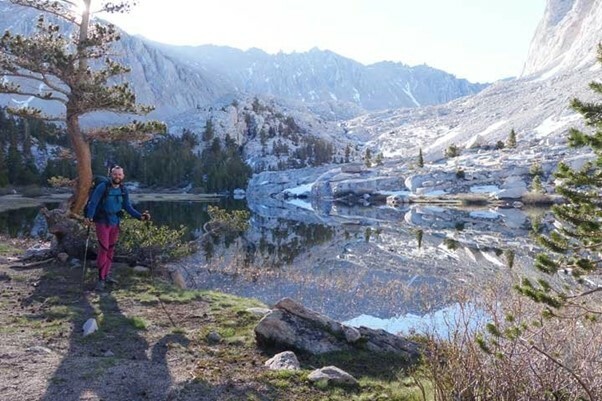
Rocking some particularly great leggings and some truly awful hair in the Sierra.
There is a weather window for attempting to compete the whole route in one go. Heading North, It should be started in April or May, early enough that the deserts are not too hot and waterless, but late enough that the snow in the California mountains should be passable by the time you arrive. The aim of most hikers is to finish before the end of September, before the snow starts to come and close off the northern stretches of trail.
Many hikers section hike smaller portions of the PCT. The most famous section is the John Muir Trail, a 211 mile section through the Sierra Nevada from Mt Whitney to Yosemite National Park. This section is one of the highlights of the PCT, but other lesser travelled sections in Oregon and Washington easily rival the JMT for beauty and enjoyment, and you will have far fewer hikers to share the trail with.
Along with the stunning scenery, one of the highlights of the trail was the community surrounding it. The generosity of the other hikers surpassed anything I would expect, and the local people supported the hikers, taking them in, hosting, caring and feeding them during resupply stops in towns along the way. Living in the backcountry for so long lets you have some incredible wildlife encounters. I saw countless lizards and snakes, black bears, eagles, and an incredibly lucky face to face meeting with a wolf, just north of Snoqualmie Pass in Washington.
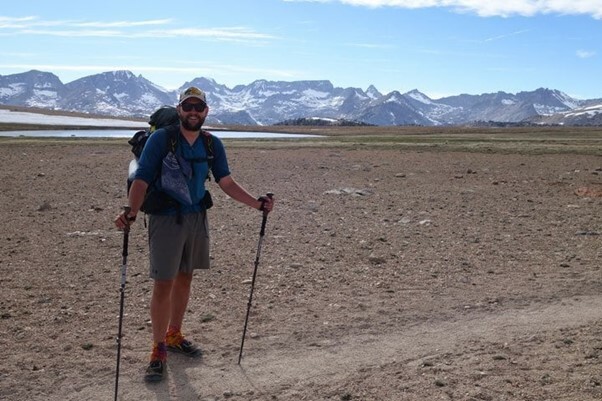
On Bighorn Plateau shortly after descending Mt Whitney. About mile 765.
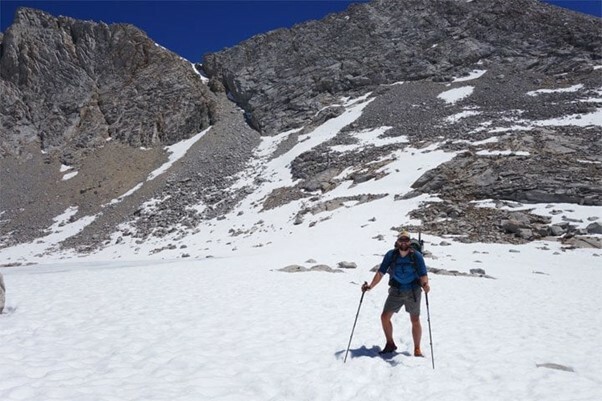
Ready to climb up Forester Pass. This is officially the highest point on trail. Mile 779.
Perhaps foolishly, I didn't do any training for this trip, but the one thing I did right before I started was making sure I took the right equipment. I hadn't done any backpacking since Scouts a decade earlier or even hiked more than 25 miles in a trip, so this was quite the learning experience!
I knew I wanted to have a lightweight pack, but didn't have and real experience with what was good or not. Ultralight Outdoor Gear was incredibly useful for this, selling many great products like the ULA packs which were difficult to find anywhere else in Europe. I was really happy with all the kit on my list, and didn't ditch or swap anything major on the whole trail.
The majority of hikers on the trail had a similar approach to their equipment – as minimal and lightweight as possible. Most had a base weight (everything in your pack except food, fuel and water) of around 15lb, (6.8kg), and a good number were hiking with a sub 10lb (4.5kg) pack weight. Lightweight gear is particularly important on long hikes as the addition of a hundred or so miles worth of food and a few litres of water, and that backpack base weight can easily double.
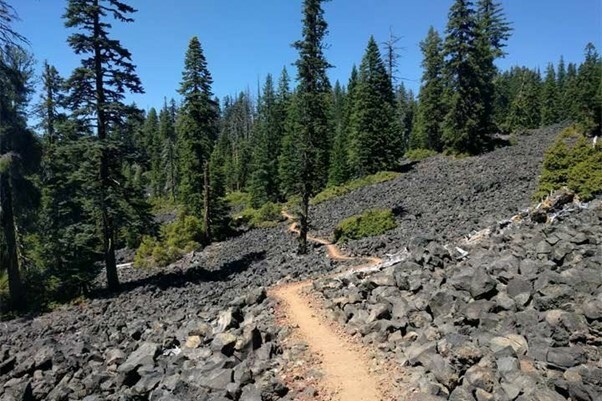
Oregon Lava Fields
The heaviest my pack ever got was as I left the Southern California desert into the Sierra Nevada mountains. For a few hundred miles through Kings Canyon, Sequoia and Yosemite National Parks, the National Parks Service mandates that all food is carried in a bear proof canister. I also took along an ice axe and microspikes in this section, and on the first day started out with an uncomfortably heavy 46lb (21kg) pack.
Without hesitation, my pack was one of the best items I took. I used the ULA Circuit, which I had heard was a the most popular pack on the trail, so I took a risk on and bought one to try. It was absolutely perfect, and its it still looks in fantastic shape, even after 2650 miles on trail. I loved how versatile it was, with the roll top allowing me to really minimise the pack size when not carrying too much stuff, but also capable easily fit in a 120 miles of food if I needed to.
The other bit of kit I got right was my rain gear. I took a OR Helium II jacket, which was great, but the real winners were the ULA Rain Kilt and the Euroschirm Liteflex Umbrella. It might sound ridiculous carrying an umbrella on a long hike, but I'll never go on trail without it again. I had the silver top model, and rigged it onto my backpack strap with velcro ties. It provided very welcome cool shade when hiking in the desert, and during rain or snow showers, I used it with the rain kilt to stay dry, but ventilated, and avoided getting sweaty and humid inside a jacket.

A view over the Northern Cascades in Washington
The last bit of kit I will give a special mention of is the Sawyer Squeeze water filter. Water is a concern through much of the trail, with limited supply through the desert sections, and some waterless stretches over 30 miles long. This filter was genuinely a lifesaver, being incredibly simple to use, and creating clear and safe water from the some very questionable sources. The majority of PCT hikers used Sawyer filters, and almost everyone I met agreed that the Squeeze is definitely worth the weight penalty over the Sawyer Mini.
As I hinted to at the start, the PCT is only the start of my long distance hiking plans. I hope to complete the GR20 across Corsica this summer, and plan to take on the 3100 mile Continental Divide Trail next summer. For the GR20 trip, I made my own backpack and tried to see how I would cope with an even lighter backpack, while on the CDT I plan to go back an use the same ULA Circuit which has already served me so well.
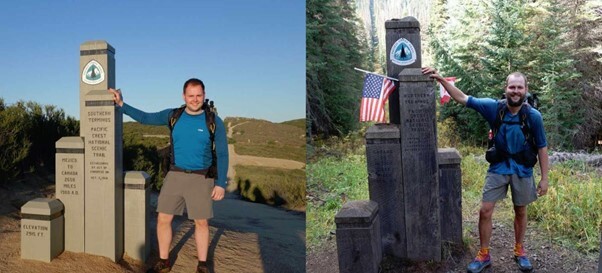
This is me at the start and end of the trail. Pretty much everything in the pack is the same, although I changed a little bit…
Chris' PCT Kit List
Category & Weight
Big Three - 2.87 kg
Equipment - 1.66 kg
Carried Clothing - 0.84 kg
Worn Clothing - 0.49 kg
Navigation - 0.1 kg
Electronics - 0.56 kg
Luxury - 0.66 kg
Hygiene - 0.11 kg
Consumables - 0 kg
Section items - 0 kg
Total 7.3kg
Worn 1.02 kg
Base Weight 6.29 kg
Big Three - ULA Circuit Backpack - 1088g
Six Moon Designs Skyscape Trekker Tent - 684g
SilNylon groundsheet - 115g
Thermarest Z-Lite Sol R Value 2.60 -5 sections (150grams) - 260g
Enlightened Equipment Revelation 20 degree - 21.79oz
Sleeping Bag liner - 110g
Total: 2.87 kg
Equipment - Black Diamond Cork Alpine Hiking Poles - 530g
Jetboil Sol Titanium Without pot stand, base cup - 274g
Titanium Spoon - 19g
Chromedome Umbrella - 213g
Black Diamond Spot Headlamp - 94g
Sawyer Squeeze Water Filter 3oz
Mosquito Net - 12g
4L Dry Bag Sea to Summit Ultra Sil Nano - 19g
8L dry bag Sea to Summit Ultra Sil Nano - 24g x2
ULA SilNylon Stuff Sack Food bag - 20g
Pen knife Leatherman Style CS - 41g
Trowel MSR Blizzard tent stake - 32g
Platypus water bladder 2 litre - 34g x2
Smart water bottle 1 litre - 28g x2
Lighter Mini Bic - 22g
Passport/money/permit etc - 100g
LokSak 4x7 Waterproof Bag 6g x2
Wallet Eagle Creek Zip Stash - 15g
Total weight: 1.66kg
Carried Clothing - ULA Rain kilt (large) - 91g
Mountain Hardware Ghost Whisperer Down jacket - 236g
Outdoor Research Helium II Jacket - 180g
Thermal Trousers Helly Hansen - 100g
Thermal Top Helly Hansen - 100g
Buff - 37g
Gloves Ski silk liners with medical latex gloves - 25g
Towel Super light trek towel - 25g
Spare socks - 50g
Total weight: 0.84kg
Worn Clothing - Socks Darn Tough - 53g
Underwear Exofficio Sport - 78g
Running Shorts Under Armour - 126g
Shirt Rab Aeon long sleeve - 110g
Dirty Girl Gaiters - 0g
Shoes La Sportiva Helios SR - 0g
Sun Hat Trucker cap - 50g
Bandana - 50g
Sunglasses - 21g
Total Weight: 0.49kg
Navigation - Maps Halfmile/Guthook/Hikerbot - 70g
Silva Field Compass - 31g
Total Weight: 0.1kg
Electronics - 10000 mAh Battery Pack Anker Powercore+ - 236g
Nexus 5x 32gb - 130g
SPOT Gen3 SOS GPS - 114g
Headphones - 12g
USB Cables Micro USB and USB C - 10g
USB Wall Plug - 60g
Total Weight: 0.56kg
Luxury - Notebook - 50g
Kindle - 211g
iPod Classic - 120g
Sony RX100 II 281g without case (330g incl case) - 281g
Total Wight: 0.66kg
Hygiene - Toothbrush - 18g
Toothpaste - 0g
Toilet paper - 0g
Hand Sanitizer - 25g
Lip balm SPF - 0g
Sunscreen - 20g
First Aid Kit - 50g
Total Weight: 0.11kg
Consumables - 100g Gas cylinder
Fuel - 160g
Water per litre - 1kg
Food per day - 1kg
Total Weight: 0kg
Section items - Kahtoola Microspikes Sierras only 360g
Bear box Sierras only - 2.9lb
Ice Axe Sierras only - 450g
Total Weight: 0kg
